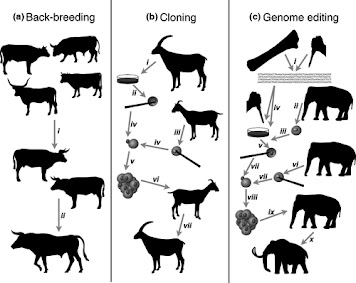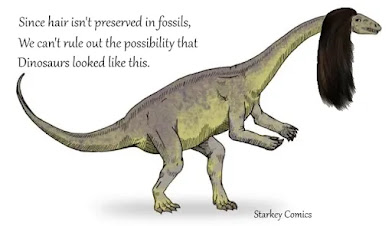In coming years can we see extinct species roaming around?
October 30, 2022
By: Eraj Zehra
De-extinction,
sounds fascinating, many scientists have already plotted some scientific
methods and are on the verge to resurrect the species that went extinct in past
few years. Some of the scientific ways of de-extinction that are adopted by the
scientists are cloning, back-breeding and genetic engineering.
Picture 1: Methods of
de-extinction
Yes, resurrection of
Pyrenean ibex through cloning is the first successful de-extinction in the
history, but the question arises that how it actually happened. One of the
scientists Dr. Alberto Fernandez Arias injected a nucleus from Celia’s (last
ever bucardo) preserved cells to goat eggs that were emptied of their own DNA. These
eggs were further inserted into hybrids between Spanish ibex and domestic goats
however, only 7 animals out of 57 were able to reach pregnancy but only one of
them was carried to term. Finally, through this method a bucardo was born in
2003 nonetheless, Celia’s clone died a few minutes later due to a lung failure.(Source)
Picture 2 : Cloning of a Pyrenean ibex
Revival
of Passenger Pigeon by back breeding:
It is one of the most important
example of extinction in the history. Despite the fact of its huge significance,
increasing demand for pigeon meat and loss of habitats caused their extinction.
However, the story is not ended here as some scientists badly wanted to be a
part of this technological race, so with the help of back breeding they use
band tail pigeon-genetically similar living specie to the extinct one-and
selectively bred it for the characteristics of a now extinct species which in
this case is passenger pigeon.(Source)
Picture 3: Passenger Pigeon
According to me, in Jurassic world
scientists just focused on DNA based resurrection of an animal but failed to
shed light on the consequences of how dinosaurs would deal to the invasive
species that have arrived after their extinction. On the contrary, Dan Marsh an
education director, questioned about the return of passenger pigeon:
"Is the world really ready for passenger
pigeons again? Is there a place for them? What's the point? It's a neat trick.
It's not really a passenger pigeon, though. What are you actually bringing
back?". Scientists can’t
recreate the passenger pigeon as an identical clone from a historical genome,
but can recreate distinct pigeon genes now, the only remaining challenge would
then be to teach the resulting hybrid band-tailed on how to thrive in an
existing ecosystem.(Source)
Picture 4: A Passenger Pigeon
What if we see a Tasmanian tiger
(Thylacine) roaming around?
Scientists are trying hard in bringing back the Tasmanian tiger which went extinct in 1936. Gene editing is a method that intends to transform the cell of a Thylacine’s closest native relative-either a Numbat or a Dunnart- into a Thylacine cell, which further would be converted into an embryo either in a petri dish or womb of a living organism. This embryo would then be embedded into a female Thylacine, leading to the birth of a Thylacine baby. (Source)
Picture 5: Professor Andrew Pask, leader of TIGRR Lab with a preserved thylacine fetus
The video demonstrates
the formation of two female macaques through cloning.
Meet the First Monkey Clones Of Their Kind | National
Geographic - YouTube
But what about unintended repercussions?
The most common one is
natural selection. If natural selection would affect the man-made genome
modifications-in unknown ways-then all efforts of humans would be washed away
as we saw in Jurassic World how the behavior of dinosaurs changed. They became
aggressive and furious once released in the environment, regardless of the
training so in my view, all these behavioral changes were most probably a
result of natural selection.
Picture 6: Owen Grady and a Velociraptor
Is de-extinction really necessary?
In some ways, yes for
some reasons it is needed as bringing back the extinct species would help
preserve biodiversity as every single animal is associated with some
significant roles in the ecosystem resulting in the rehabilitation of the
declined ecosystem. A coin always has two sides just like this de-extinction
along with its benefits also have some drawbacks such as will the revived
species be able to adjust themselves according to there roles in the ecosystem
or is there really enough habitats for them to thrive? Moreover, species could
carry various pathogens when brought back to life.
Reason behind de-extinction in the movie:
In my opinion, the most compelling reason for resurrection of animals is the same as it was in Jurassic World. In the movie, a theme park was built keeping in mind a business prospect as they thought new attraction would bring more customers but all the scientific and ethical terms were crossed which in turn declined the number of happy customers.
A Failed Attempt:
Scientists tried to
recover the genome of a Christmas Island rat which became extinct more than 100
years ago, but were not able to succeed as 5% of its DNA was impossible to
recover fully.(Source)
Picture 7:
A Christmas Island rat
Can Jurassic World be a reality?
No, it cannot be a
reality as de-extinction of dinosaurs is completely impossible, due to the fact
that they went extinct 65 million of years ago which is a very long period for
a genetic material to survive. The only way we can see Velociraptors is to
watch or read a book as there is little to no hope of resurrecting the extinct
ones.
Picture 8: Just to
end on a funny note 😊
References:
“The Guardian View on De-Extinction: Jurassic Park May Be Becoming Reality.”
19 Aug. 2022, https://www.theguardian.com/commentisfree/2022/aug/19/the-guardian-view-on-de-extinction-jurassic-park-may-be-becoming-reality.
Accessed 30 Oct. 2022.
DeMio, Terry. “Martha, the
Last of Her Species, Might Lose That Distinction If Scientists Have Their Way.”
29 Aug. 2019,
https://www.cincinnati.com/story/news/2019/08/29/biotechnology-de-extinction-science-could-recreate-passenger-pigeons/2138998001/.
Accessed 30 Oct. 2022.
Fan, Shelly. “De-Extinction
Is Now a Thing—Starting With Passenger Pigeons.” 23 Oct. 2018,
https://singularityhub.com/2018/10/23/de-extinction-is-now-a-thing-starting-with-passenger-pigeons/.
Accessed 30 Oct. 2022.
Levenson, Eric. “De-Extinction
Scientists Want to Make 'Jurassic Park' of Woolly Mammoths a Real Thing.” 27
Feb. 2014,
https://www.theatlantic.com/culture/archive/2014/02/de-extinction-scientists-want-make-jurassic-park-woolly-mammoths-real-thing/358598/.
Accessed 30 Oct. 2022.
Rincon, Paul. “Fresh Effort to Clone Extinct Animal.” 22 Nov. 2013, https://www.bbc.com/news/science-environment-25052233Accessed 30 Oct. 2022.
SHULTZ, DAVID. “Bringing
Extinct Species Back from the Dead Could Hurt—Not Help—Conservation Efforts.”
27 Feb. 2017,
https://www.science.org/content/article/bringing-extinct-species-back-dead-could-hurt-not-help-conservation-efforts.
Accessed 30 Oct. 2022.
References of images:
5)
https://newatlas.com/biology/thylacine-deextinction-tigrr-lab-colossal/#gallery:2
8)
https://starkeycomics.com/2019/01/15/the-dinosaur-with-hair/










Comments
Post a Comment